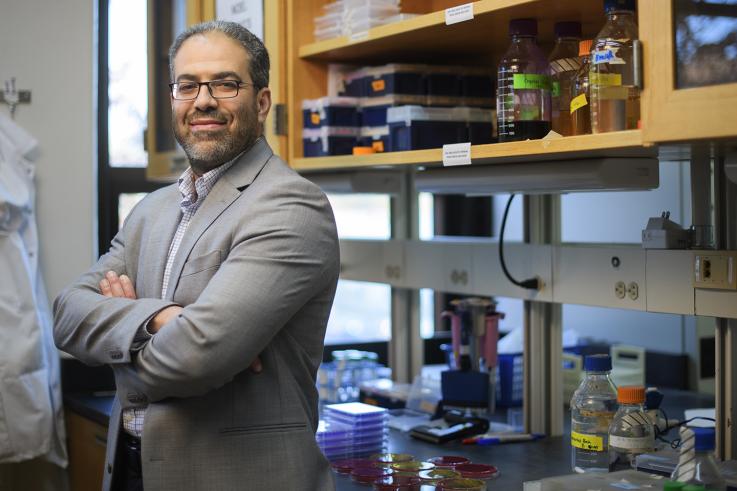Infection specialists are also focusing on getting hospitals to do a better job at containing resistant bugs when they pop up, instead of spreading them among patient populations. About 5 percent of all patients in U.S. hospitals end up with a “nosocomial” infection—that is, an infection acquired at the hospital. It's not hard to see how. Hospitals are dense gatherings of sick people with weakened immune systems and various wounds and punctures, constantly poked and prodded by fingers and tools that move around the hospital to poke and prod others.
感染專(zhuān)家還致力于讓醫(yī)院更好地控制耐藥性細(xì)菌的出現(xiàn),而不是在患者中傳播。在美國(guó)醫(yī)院里,大約有5%的病人最終會(huì)患上“院內(nèi)感染”,也就是在醫(yī)院里獲得的感染。不難看出原因。醫(yī)院里密集地聚集著免疫力低下的病人,他們身上有各種各樣的傷口和刺傷,不斷地被手指和工具戳來(lái)戳去。

An aging population and new procedures have left patients all the more vulnerable. Johns Hopkins' Zenilman found in an informal survey he conducted that more than half of all the patients he asked had some sort of implant, a common source of infection. “The patients in hospitals today as a group are much sicker than any we've seen in history,” he says. “Research shows that, on average, hospitals aren't following the right precautions about half the time,” says the Association for Professionals in Infection Control and Epidemiology's Hoffmann. “It's our biggest struggle.”
人口老齡化和新的治療方法使得病人更加脆弱。約翰霍普金斯大學(xué)的澤尼曼在他進(jìn)行的一項(xiàng)非正式調(diào)查中發(fā)現(xiàn),在他詢(xún)問(wèn)的所有病人中,有一半以上的人接受了某種植入物,這是一種常見(jiàn)的感染源。“今天醫(yī)院里的病人作為一個(gè)整體比我們歷史上見(jiàn)過(guò)的任何病人都要嚴(yán)重,”他表示。“研究表明,平均而言,醫(yī)院有一半的時(shí)間沒(méi)有采取正確的預(yù)防措施,”感染控制和流行病學(xué)專(zhuān)業(yè)人員協(xié)會(huì)的霍夫曼稱(chēng)。“這兒是我們最大的困境。”
Hospitals are beginning to change their ways. Many now use trash can–shaped robots to disinfect walls with ultraviolet light (the rooms have to be empty because the light is harmful to humans too). At Riverside Medical Center, south of Chicago, two robots from a company called Xenex disinfect more than 30 rooms a day.
醫(yī)院開(kāi)始改變他們的方式。現(xiàn)在很多人用垃圾桶形狀的機(jī)器人用紫外線(xiàn)給墻壁消毒(房間必須是空的,因?yàn)樽贤饩€(xiàn)對(duì)人類(lèi)也有害)。在芝加哥南部的河畔醫(yī)療中心,來(lái)自Xenex公司的兩個(gè)機(jī)器人每天為30多個(gè)房間消毒。
Keeping hospitals clean would be easier if bacteria couldn't stick to surfaces such as tabletops and clothes. Melissa Reynolds, a Colorado State University biomedical engineer, is developing new bacteria-resistant materials. Health care workers' clothing and other hospital materials and surfaces wouldn't need as much disinfection if they didn't pick up bugs in the first place. Fighting bacteria is accidental mission for Reynolds. She had been investigating ways of avoiding clots in the meshes that surgeons use to keep patients' arteries open. Applying a coating of copper nanocrystals to the meshes seemed to keep blood cells from sticking to the surfaces. She noticed that bacteria didn't stick to the nanocrystal coatings either. Then a student in her lab had a eureka moment: Why not dip cotton fabric in a solution of the nanocrystals to keep bacteria from sticking to the fabric? “We were discovering new materials with strong antibiotic properties,” says Reynolds. “That led us in a new direction.”
如果細(xì)菌不能附著在桌面和衣服等表面,那么保持醫(yī)院的清潔就容易多了。科羅拉多州立大學(xué)生物醫(yī)學(xué)工程師梅麗莎·雷諾茲正在開(kāi)發(fā)新的抗菌材料。如果醫(yī)護(hù)人員的衣服、醫(yī)院的其他材料和表面一開(kāi)始就沒(méi)有感染病菌,就不需要那么多的消毒。對(duì)雷諾茲來(lái)說(shuō),對(duì)抗細(xì)菌是一項(xiàng)附加任務(wù)。她一直在研究如何避免外科醫(yī)生用來(lái)保持病人動(dòng)脈暢通的網(wǎng)狀結(jié)構(gòu)中出現(xiàn)血栓。在網(wǎng)格上涂上一層銅納米晶似乎可以防止血細(xì)胞粘附在網(wǎng)格表面。她注意到細(xì)菌也不會(huì)粘附在納米晶體涂層上。然后,她實(shí)驗(yàn)室里的一名學(xué)生靈光一閃:為什么不把棉織物浸入納米晶體溶液中,以防止細(xì)菌粘在織物上?“我們發(fā)現(xiàn)了具有強(qiáng)大抗菌性能的新材料,” 雷諾茲說(shuō)。“這把我們引向一個(gè)新方向。”
譯文由可可原創(chuàng),僅供學(xué)習(xí)交流使用,未經(jīng)許可請(qǐng)勿轉(zhuǎn)載。












